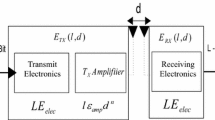Abstract
In this paper, we propose a new energy efficient clustering scheme with transmission power control named “EACLE” (Energy-Aware CLustering scheme with transmission power control for sEnsor networks) for wireless sensor networks, which are composed of the following three components; “EACLE clustering” is a distributed clustering method by means of transmission power control, “EACLE routing” builds a tree rooted at a sink node and sets the paths from sensor nodes taking energy saving into consideration, and “EACLE transmission timing control” changes the transmission timing with different levels of transmission power to avoid packet collisions and facilitates packet binding.
With an indoor wireless channel model which we obtained from channel measurement campaigns in rooms and corridors and an energy consumption model which we obtained from a measurement of a chipset, we performed computer simulations to investigate the performance of EACLE in a realistic environment. Our simulation results indicate that EACLE outperforms a conventional scheme such as EAD (Energy-Aware Data-centric routing) in terms of communication success rate and energy consumption. Furthermore, we fully discuss the impact of transmission power and timing control on the performance of EACLE.
Similar content being viewed by others
References
I.F. Akyildiz, W.Su, Y.Sankarasubramaniam, and E.Cayirci, “A Survey on Sensor Networks”, IEEE Comm. Mag., Vol.40, No.4, pp. 102–114, 2002.
D.Estrin, R.Govindan, J.Heidemann, and S.Kumar, “Next Century Challenges: Scalable Coordination in Sensor Networks”, in Proc. MobiCom 1999, Seattle, Washington, 1999.
B.Chen, K.Jamieson, H.Balakrishnan, and R.Morris, “Span: An Energy-Efficient Coordination Algorithm for Topology Maintenance in ad hoc Wireless Networks”, Mobile Computing and Networking, pp. 85–96, 2001.
A.Boukerche, X.Cheng, and J.Linus, “Energy-Aware Data-Centric Routing in Microsensor Networks”, Proc. MSWiM ’03, San Diego, ACM, Sep, 2003.
IEEE Std 802.15.4TM, IEEE Standard for Information technology–Telecommunications and information exchange between systems–Local and metropolitan area networks–Specification requirements–Part 15.4: Wireless Medium Access Control (MAC) and Physical Layer (PHY) Specifications for Low-Rate Wireless Personal Area Networks (WPANs), 2003.
http://www.chipcon.com/.
S.Hara, D.Zhao, K.Yanagihara, J.Taketsugu, K.Fukui, S.Fukunaga, and K.Kitayama, “Propagation Characteristics of IEEE 802.15.4 Radio Signal and their Application for Location Estimation”, Proc. IEEE VTC ’05, Stockholm, Sweden, May 2005.
C.Perkins, E.Belding-Royer, and S.Das, “Ad hoc On-Demand Distance Vector (AODV) Routing”, RFC3561, IETF, July 2003.
N.Poojary, S.Krishnamurthy, and S.Dao, “Medium Access Control in a Network of ad hoc Mobile Nodes with Heterogeneous Power Capabilities”, Proc IEEE ICC 2001, Helsinki , 2001. ad-hoc networks.” Proc. 8th ACM Mobicom, Atlanta, GA, Sept. 2002.
Author information
Authors and Affiliations
Corresponding author
Rights and permissions
About this article
Cite this article
Yanagihara, K., Taketsugu, J., Fukui, K. et al. EACLE : Energy-Aware Clustering Scheme with Transmission Power Control for Sensor Networks. Wireless Pers Commun 40, 401–415 (2007). https://doi.org/10.1007/s11277-006-9199-2
Published:
Issue Date:
DOI: https://doi.org/10.1007/s11277-006-9199-2




